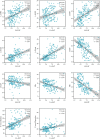Redistribution of adipose tissue is associated with left atrial remodeling and dysfunction in patients with atrial fibrillation
- PMID: 36035916
- PMCID: PMC9403614
- DOI: 10.3389/fcvm.2022.969513
Redistribution of adipose tissue is associated with left atrial remodeling and dysfunction in patients with atrial fibrillation
Abstract
Objective: Adipose tissue is recognized as a crucial regulator of atrial fibrillation (AF). However, the effect of epicardial adipose tissue (EAT) on the pathophysiology of AF might be different from that of other adipose tissues. The purpose of this study was to explore the distribution features of different adipose tissues in AF patients and their relationships with left atrial (LA) remodeling and function.
Methods: A total of 205 participants (including 112 AF and 93 non-AF patients) were recruited. Color doppler ultrasound was used to measure the thickness of subcutaneous, extraperitoneal, and intra-abdominal adipose tissue. Cardiac CT scan was performed to measure the mean thickness of EAT surrounding the whole heart (total-EAT) and specific regions, including left atrium (LA-EAT), left ventricle, right ventricle, interventricular groove, and atrioventricular groove. LA anatomical remodeling and function were measured by echocardiography, while electrical remodeling was evaluated by P-wave duration and dispersion using Electrocardiography (obtained after cardioversion or ablation in AF patients). Relationship between the thickness of different adipose tissues and LA remodeling and function was analyzed.
Results: The thickness of subcutaneous, extraperitoneal, and intra-abdominal adipose tissue was similar between AF and non-AF patients, and had no or only weak association with LA remodeling and dysfunction. However, compared to non-AF participants, total-EAT thickness significantly increased in both paroxysmal and persistent AF patients (non-AF vs. paroxysmal AF vs. persistent AF: 6.31 ± 0.63 mm vs. 6.76 ± 0.79 mm vs. 7.01 ± 1.18 mm, P < 0.001), which was positively correlated with the LA size and P-wave duration and dispersion, and negatively correlated with LA ejection fraction and peak strain rate. More interestingly, EAT thickness in AF patients did not increase uniformly in different regions of the heart. Compared to EAT surrounding the other regions, LA-EAT was found to accumulate more greatly, and had a closer relationship to LA remodeling and dysfunction. Multivariate logistic regression analysis also showed that LA-EAT was significantly correlated with the presence of AF (OR = 4.781; 95% CI 2.589-8.831, P < 0.001).
Conclusion: Rather than other adipose tissues, accumulation and redistribution of EAT, especially surrounding the LA, is associated with LA remodeling and dysfunction in AF patients.
Keywords: atrial fibrillation; cardiac remodeling; dysfunction; epicardial adipose tissue; left atrial remodeling.
Copyright © 2022 Chen, Chen, Wang, Zhong, Zhang, Wu, Zheng, Xie, Zhu, Tang and Li.
Conflict of interest statement
The authors declare that the research was conducted in the absence of any commercial or financial relationships that could be construed as a potential conflict of interest.
Figures






Similar articles
-
Epicardial adipose tissue dispersion at CT and recurrent atrial fibrillation after pulmonary vein isolation.Eur Radiol. 2024 Aug;34(8):4928-4938. doi: 10.1007/s00330-023-10498-2. Epub 2024 Jan 10. Eur Radiol. 2024. PMID: 38197916 Free PMC article.
-
[Association between inflammation activity of left atrial epicardial adipose tissue measured by 18F-FDG PET/CT and atrial fibrillation].Zhonghua Xin Xue Guan Bing Za Zhi. 2021 Dec 24;49(12):1213-1219. doi: 10.3760/cma.j.cn112148-20211026-00913. Zhonghua Xin Xue Guan Bing Za Zhi. 2021. PMID: 34905899 Chinese.
-
Electroanatomical Remodeling of the Atria in Obesity: Impact of Adjacent Epicardial Fat.JACC Clin Electrophysiol. 2018 Dec;4(12):1529-1540. doi: 10.1016/j.jacep.2018.08.014. Epub 2018 Nov 1. JACC Clin Electrophysiol. 2018. PMID: 30573116
-
Role of epicardial adipose tissue in human atrial fibrillation.J Arrhythm. 2023 Feb 19;39(2):93-110. doi: 10.1002/joa3.12825. eCollection 2023 Apr. J Arrhythm. 2023. PMID: 37021018 Free PMC article. Review.
-
Epicardial Adipose Tissue and Atrial Fibrillation Recurrence following Catheter Ablation: A Systematic Review and Meta-Analysis.J Clin Med. 2023 Oct 5;12(19):6369. doi: 10.3390/jcm12196369. J Clin Med. 2023. PMID: 37835012 Free PMC article. Review.
Cited by
-
Predictive Value of Epicardial Adipose Tissue for Hemorrhagic Transformation and Functional Outcomes in Acute Ischemic Stroke Patients Undergoing Intravenous Thrombolysis Therapy.J Inflamm Res. 2024 Dec 31;17:11915-11929. doi: 10.2147/JIR.S499351. eCollection 2024. J Inflamm Res. 2024. PMID: 39758939 Free PMC article.
References
-
- Hindricks G, Potpara T, Dagres N, Arbelo E, Bax JJ, Blomström-Lundqvist C, et al. 2020 ESC guidelines for the diagnosis and management of atrial fibrillation developed in collaboration with the european association for cardio-thoracic surgery (EACTS)the task force for the diagnosis and management of atrial fibrillation of the european society of cardiology (ESC) developed with the special contribution of the european heart rhythm association (EHRA) of the ESC. Eur Heart J. (2021) 42:373–498. 10.1093/eurheartj/ehaa612 - DOI - PubMed
-
- Dai H, Zhang Q, Much AA, Maor E, Segev A, Beinart R, et al. Global, regional, and national prevalence, incidence, mortality, and risk factors for atrial fibrillation, 1990–2017: results from the global burden of disease study 2017. Eur Heart J Qual Care Clin Outcomes. (2020) 7:574–82. 10.1093/ehjqcco/qcaa061 - DOI - PMC - PubMed
LinkOut - more resources
Full Text Sources

